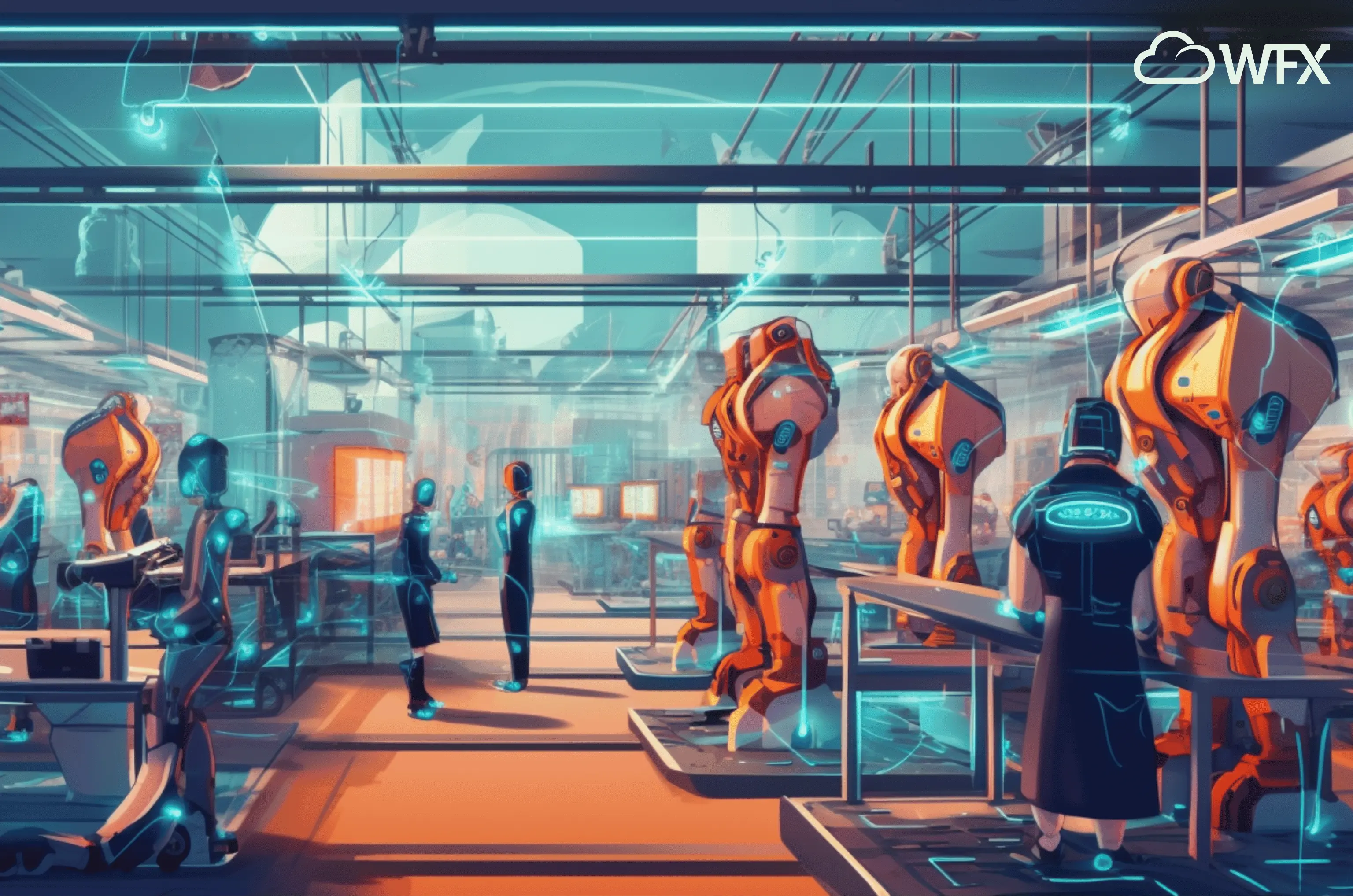10 technology trends defining the future of textile and garment manufacturing
-
Introduction
In this era of digital revolution, where bytes and pixels permeate every aspect of our lives, it’s no surprise that technology is leaving its indelible mark on the clothes we wear.
Traditional looms and sewing machines are giving way to soft robotics and artificial intelligence (AI), while fabrics themselves are becoming smarter and more functional.
Technology, the master architect of progress, has become a driving force in reshaping the future of the textile and garment manufacturing industry. The fusion of technology with textiles and garments is revolutionizing the way we design, produce, and consume fashion, birthing a new era of possibilities.
In this article, we delve into the realm of textile and garment manufacturing, exploring ten remarkable technology trends that are shaping the future of the industry. Join us on this captivating journey as we unravel the threads of the future, where fashion and technology intertwine to create a tapestry of endless possibilities!
-
Top 10 Technology Trends for the Textile & Garment Industry
1. Sustainable Manufacturing & Green Practices
The textile and garment industry are embracing sustainability and green practices to reduce their environmental impact and meet consumer demand for eco-friendly products.
- Energy Efficiency: Manufacturers are optimizing energy usage and investing in advanced machinery to significantly reduce carbon emissions and contribute to a greener future.
- Water Saving: Water-saving dyeing and finishing techniques, such as low-water and waterless processes, minimize water consumption and chemical usage while mitigating wastewater discharge.
- Renewable Electricity: Many garment and textile factories have also shifted towards renewable electricity sources, such as solar panels and wind turbines, or are using energy-efficient lighting systems like LED lights. Motion detectors are also employed to control lighting, resulting in substantial energy savings.
- End Packaging Waste: To minimize waste, unnecessary packaging materials such as plastic bags, hand tags, and staple pins have been eliminated entirely from many factories. Many are also exploring sustainable alternatives like recycled or biodegradable packaging as per buyer demand.
IMPACT: These sustainable manufacturing and green practices will reduce the industry’s environmental footprint, meet consumer preferences for eco-friendly products, and offer potential cost savings in the long run.
2. End-to-End Digital Transformation
Digital transformation is revolutionizing textile and garment manufacturing by integrating digital technologies throughout the entire value chain, from design to distribution. This comprehensive shift is enhancing efficiency and customer satisfaction through various means.
- Cloud-Based Tools: Integrated digital tools like Product Lifecycle Management (PLM) and Enterprise Resource Planning (ERP) software are pivotal in this digital journey. They facilitate seamless communication and collaboration, reducing the need for extensive business travel and meetings. Manufacturers can connect digitally with buyers, designers, and production units, ensuring efficient coordination and minimizing lead times.
- Data Analytics: Manufacturers are leveraging streamlined data analytics from disparate sources to make informed decisions and optimize their processes. Valuable insights into buyer preferences, factory efficiency, and production performance enable them to streamline operations and deliver high quality products more quickly.
- Collaboration Tools: Companies are also leveraging digital platforms to enhance communication with suppliers. Cloud-based systems enable real-time order tracking, inventory management, and production monitoring. This level of transparency and connectivity results in smoother operations, fewer errors, and quicker response times.
IMPACT: Manufacturers experience increased efficiency throughout the value chain, from design to distribution. Streamlined processes, data-driven decision-making, and improved communication lead to reduced lead times, cost savings, and heightened customer satisfaction.
3. The Interplay of Digital Twins, AR/VR and IoT

The convergence of digital twins, augmented reality (AR), virtual reality (VR), and the Internet of Things (IoT) enables the creation of digital replicas of real-world objects and environments, fostering real-time monitoring, simulation, and enhanced decision-making processes.
- Digital Twins: Digital replicas of machines, products, or even entire factories are now being used to monitor the performance of these assets in real time. Smart Factory tools provide real-time insights into the performance, condition, and behavior of their physical counterparts by harnessing sensor data, connectivity, and advanced analytics. These replicas can even help you monitor assets remotely, identify anomalies, and simulate various scenarios to optimize performance and reduce downtime.
- AR/VR: AR overlays digital information onto the real world, while VR creates immersive virtual environments. AR/AR tech helps showcase products in interactive and engaging ways, allowing customers to visualize and customize them before making purchasing decisions. They also enable realistic training simulations, reducing the need for physical prototypes and minimizing associated costs.
- IoT (Internet of Things): The integration of IoT devices and RFID sensors further enhances the capabilities of digital twins. IoT devices and sensors collect valuable data from physical assets, providing continuous updates on factors like temperature, pressure, and performance metrics.
IMPACT: As the digital landscape continues to evolve, the synergy between digital twins, AR/VR, and IoT will only grow stronger. The ability to create accurate digital replicas, visualize products in interactive ways, and collect real-time data from physical assets offers unprecedented opportunities for businesses across industries.
4. Circular Economy and Waste Reduction
In a world grappling with environmental challenges, the circular economy has emerged as a powerful concept to mitigate waste generation and promote sustainable practices. It focuses on reducing waste through recycling, upcycling, and repurposing of materials, thereby conserving resources and minimizing environmental footprint.
- Reduce Waste: When businesses design products with durability, repairability, and recyclability in mind, they can minimize the use of virgin resources and maximize the value derived from materials. This shift towards a product lifecycle-based mindset allows for a more sustainable production model which not only benefits the environment but also enhances brand reputation and consumer loyalty.
- Resale/Repair: Take-back programs for used garments and textiles have gained significant momentum in recent years. These initiatives enable customers to return their worn-out clothing, which is then repurposed or recycled into new products.
- Disposal-first Approach: Designing products with end-of-life considerations in mind is a crucial aspect of the circular economy. Businesses employing modular design or incorporating easily separable components can facilitate the recycling and repurposing of products at the end of their lifecycle.
IMPACT: The adoption of circular economy principles is essential for businesses aiming to reduce waste and transition to more sustainable practices. Embracing the circular economy not only has a positive impact on the environment but also offers opportunities for new revenue streams and increased brand reputation in the ever-growing market for sustainable products.
5. Transparent Supply Chains and Traceability
In an era of heightened consumer awareness and demand for ethical practices, transparent supply chains and traceability have become crucial elements for businesses across industries. With the use of technologies like blockchain and traceability systems, companies can get end-to-end visibility into their apparel supply chains, ensuring ethical sourcing, responsible production practices, and enhanced consumer trust.
- Blockchain: The application of blockchain in supply chains enables the creation of immutable records, providing transparent and tamper-proof information about each step in the production and distribution process. Companies can utilize blockchain for end-to-end supply chain visibility, enabling consumers to trace the journey of a product from its origin to the store shelves.
- Traceability Systems: Implementing traceability systems allows companies to track and monitor the movement of raw materials and finished products throughout the supply chain. Technologies like RFID tags, barcodes, or QR codes can capture detailed information about the origin, manufacturing processes, and sustainability credentials of their products.
- Ethical Sourcing: Emphasizing ethical sourcing and responsible production practices is a critical aspect of transparent supply chains. Raw materials obtained from sustainable sources and production processes adhere to social and environmental standards.
IMPACT: Transparent supply chains and traceability have become imperative for businesses aiming to build consumer trust and demonstrate their commitment to responsible practices. Adoption of technologies like blockchain and implementation of traceability systems enable end-to-end visibility, fostering accountability and integrity throughout the supply chain.
6. Nearshoring, Reshoring & Localized Production
The COVID-19 pandemic has brought to light the vulnerabilities of global supply chains, prompting businesses to reevaluate their sourcing strategies. Nearshoring, reshoring, and localized production have emerged as effective solutions to enhance supply chain resilience and reduce reliance on overseas suppliers.
- Nearshoring: Nearshoring involves the relocation of production facilities closer to the home country or sourcing from neighboring regions. Shortening supply chains offers several advantages, such as reduced lead times, lower transportation costs, and increased flexibility in responding to market demands.
- Reshoring: Reshoring takes the concept further by bringing production back to the home country. This strategy provides even greater control over manufacturing processes, quality standards, and intellectual property. Reshoring not only supports domestic economies but also fosters job creation and promotes local industries.
- Localization: Localized production emphasizes collaboration and partnerships within a specific region. By working closely with local suppliers, businesses can establish resilient and efficient supply chains. Collaboration enables shared knowledge, expertise, and resources, leading to improved productivity, reduced costs, and enhanced innovation.
IMPACT: These strategies have the potential to create new job opportunities, revitalize local industries, and support sustainable economic growth. Additionally, by shortening supply chains and reducing long-distance transportation, businesses can significantly lower carbon emissions, contributing to environmental sustainability.
7. Artificial Intelligence (AI) in Design and Production
Like most things, the integration of Artificial Intelligence (AI) in design and production processes will completely revolutionize the way manufacturing businesses operate. AI will allow companies to optimize design, streamline production planning, and implement advanced quality control systems.
- AI for Design: AI-powered tools have become invaluable assets in design optimization and trend forecasting. These tools utilize machine learning algorithms to analyze vast amounts of data and generate design options that meet specific criteria.
- Production Planning: AI-driven tools also play a crucial role in production planning and scheduling. Using historical data, market trends, and other variables, AI algorithms can generate accurate forecasts and optimize production plans. These tools enable businesses to achieve optimal inventory levels, reduce waste, and avoid overstocking, resulting in cost savings and improved operational efficiency.
- Computer Vision: AI-powered systems can analyze visual data and detect defects or anomalies in products with high precision and speed. This allows for early detection of issues, reducing the likelihood of faulty products reaching consumers and minimizing the costs associated with recalls or rework.
IMPACT: The integration of AI enhances efficiency, reduces waste, and improves product quality, leading to cost savings and increased customer satisfaction. As AI continues to advance, its potential to revolutionize design and production processes will only grow, offering businesses new avenues for innovation and success.
8. Smart Textiles and Functional Wearables
The convergence of soft robotics and fabrics has given rise to a new era of innovation with the development of smart textiles and functional wearables. Companies are now creating truly ‘connected’ garments that go beyond traditional clothing, offering enhanced functionality and a myriad of applications.
- Next-Gen Textiles: Smart textiles involve the incorporation of soft robotics and electronics into fabrics, resulting in garments that can adapt, respond, and interact with the wearer’s environment. These textiles are designed to be flexible, lightweight, and comfortable, seamlessly blending technology into everyday clothing.
- Smart Garments: Garments with built-in sensors and connectivity have become increasingly prevalent. From fitness trackers and heart rate monitors embedded into shirts to color-changing vests that respond to environmental conditions, the applications of smart textiles are vast.
- Functional Clothing: Innovations such as stain-resistant fabrics and self-cleaning properties have made their way into the market, enhancing convenience and durability of clothing.
IMPACT: The increasing market demand for these products has created opportunities for new product categories, attracting both technology and fashion fans. The seamless integration of hi-tech features into everyday garments will enhance customer satisfaction and revolutionize the way we dress.
9. Robotics & AI-Driven Automation
Robotic and AI-driven automation have brought about a revolutionary transformation in the manufacturing industry, resulting in increased efficiency, reduced labor costs, and enhanced productivity. Through the adoption of robotic systems and the utilization of AI technologies, companies are optimizing their production processes and establishing fully automated factories.
- Sewing: Robotic sewing machines have the capability to perform repetitive sewing tasks with precision and speed, reducing the need for manual labor and enhancing production efficiency. These machines can handle various fabric types and stitch patterns, ensuring consistent quality and reducing errors.
- Automated Cutting: Automated cutting systems have also emerged as a game-changer in manufacturing. These systems utilize advanced technology to accurately cut fabric or other materials based on pre-programmed patterns, significantly reducing material waste and improving production speed. Automated cutting systems enable precise and efficient cutting, leading to higher productivity and cost savings.
- AI-run Factories: The implementation of AI-driven automation goes beyond individual processes. With AI-driven automation, factories can operate with minimal human intervention, resulting in reduced labor costs and increased productivity. This has the potential to bring about reshoring, as companies can reduce reliance on overseas production facilities and bring manufacturing operations closer to their home countries.
IMPACT: The integration of AI for process optimization and decision-making establishes fully automated factories, bringing substantial benefits to the industry. They will contribute to increased productivity, reduced labor costs, and improved efficiency leading to a more competitive manufacturing landscape.
10. Collaborative Innovation and Partnerships
By forming alliances and consortiums across industries, companies are able to create shared value, leverage expertise, and drive industry-wide advancements. Collaborative efforts and joint research and development (R&D) initiatives are paving the way for new technologies and materials.
- Collaboration Over Competition: The emphasis on collaboration extends beyond traditional competitive boundaries. Companies are joining forces to tackle industry-wide challenges and drive sustainable development. For example, partnerships are being formed for the development of sustainable textiles, where companies collaborate to create eco-friendly materials and processes.
- Multi-Industry Partnerships: Cross-industry alliances and consortiums provide a platform for knowledge sharing, resource pooling, and joint problem-solving. By combining strengths, companies can tackle complex challenges that individual entities may not have been able to address effectively.
IMPACT: Joint research and development efforts are crucial for technological advancements and material innovations. This collaborative R&D approach enables companies to access a wider range of resources and expertise, ultimately leading to breakthrough innovations that benefit the entire industry.
-
Conclusion
The future of textile and garment manufacturing is being shaped by an array of transformative technology trends. From digital twins and green manufacturing to circular economy initiatives, the industry is undergoing a profound evolution. These advancements are not only enhancing operational efficiency and productivity but also driving sustainability, transparency, and customer-centricity.
As these technology trends continue to shape this industry, the manufacturing sector is poised for transformative growth. Embracing these advancements will not only drive operational efficiency but also companies position themselves at the forefront of innovation.
If you want to get ahead of these fast-moving trends, speak to WFX’s Digital Transformation expert to create a personalized digitalization strategy for your business.









